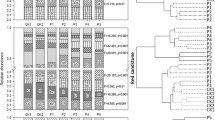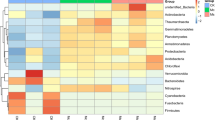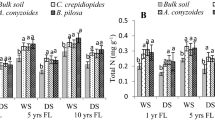Abstract
Bracken is a broadly distributed weedy fern common in disturbed habitats. Frond and rhizosphere soil samples were obtained from bracken growing in three clearcut locations in the Willamette National Forest in western Oregon. The highest frond biomass was correlated with soil having the highest total %N, lowest Fe content and oldest geological age. Based on analysis of variance of principal component scores for patterns of utilization of substrates on Biolog GN plates, metabolic profiles of rhizosphere microbial communities of bracken differed significantly between locations. Utilization of carbohydrates and phosphorylated compounds was positively correlated with organic matter (OM) and total N and negatively correlated with extractable Fe and Mn content of soil. Carboxylic acid utilization was positively correlated with pH and OM and negatively correlated with extractable Mn and P content of soils. Pseudomonas rDNA fingerprints of bracken rhizosphere samples suggested that the diversity of pseudomonads at the location with the most acidic (pH 5.5) soil (Burnside Road) differed from those at less acidic (pH 6.2 and 6.1) locations (Falls Creek and Toad Road). Mycorrhizal infection of bracken was lowest at Falls Creek, the location with the highest %N soil content. Our results suggest that bracken frond biomass and rhizosphere microbial community characteristics are correlated with local edaphic factors such as soil chemistry and geological age.
Similar content being viewed by others
References
Allen M F 1992 Mycorrhizal Functioning – An Integrative Plant Fungal Process. Routledge, Chapman and Hall, Inc. New York, NY. 534 p.
Ader K G 1990 The effect of climate and soils on bracken vigour and distribution in Scotland. No. 40, pp. 141–151. Proceedings of the International Conference Bracken 89 held in Sydney, Australia, July 1989. AIAS-Occasional Publication.
Azad H R, Davis J R, Schnathorst W C and Kado C I 1985 Relationships between rhizoplane and rhizosphere bacteria and Verticillium wilt resistance in potato. Arch. Microbiol. 140, 347–351.
Beare, M H, Coleman D C, Crossley D A Jr, Hendrix P F and Odum E P 1995 A hierarchical approach to evaluating the significance of soil biodiversity to biogeochemical cycling. Plant Soil 170, 5–22.
Boeuf-Tremblay V, Plantureux S and Guckert A 1995 Influence of mechanical impedance on root exudation of maize seedlings at two developmental stages. Plant Soil 172, 279–287.
Bowen G D and Rovira A D 1992 The rhizosphere: the hidden half of the hidden half. In Plant Roots: The Hidden Half. Eds. Y Waisel, A Eshel and U Kafkafi. pp. 641–669. Marcel Decker, New York.
Brown S, Andersen C, Beedlow P, Cairns M, HogsettW, Johnson M, McKane R, Rygiewicz P, Seidler R, Solomon A, Tingey D and Watrud L 1998 Forest Ecosystem Indicators: Monitoring, Assessment, Prediction (FEIMAP). U S Environmental Protection Agency, EPA/600/R-99/038, Office of Research & Development, Washington, DC.
Caporn S J M, Brooks A L, Press M C and Lee J A 1999 Effects of long-term exposure to elevated CO2 and increased nutrient supply on bracken (Pteridium aquilinum). Funct. Ecol. 13, 107–115.
Chapin F S III, Walker B H, Hobbs R J, Hooper D U, Lawton J H, Sala O E and Tilman D 1997 Biotic control over the functioning of ecosystems. Science 277, 500–504.
Di Giovanni G D, Watrud L S, Seidler R J and Widmer F 1999 Use of metabolic and molecular fingerprinting to compare rhizosphere microbial communities of parental and transgenic alfalfa. Microb. Ecol. 37, 129–139.
Dolling A, Zackrisson O and Nilsson M C 1994 Seasonal variation in phytotoxicity of bracken (Pteridium aquilinum L. Kuhn). J. Chem. Ecol. 20, 3163–3172.
Donegan K K, Watrud L S, Seidler R J, Maggard S P, Shiroyama T, Porteous L A and Di Giovanni G 2001 Soil and litter organisms in Pacific northwest forests under different management practices Appl. Soil Ecol. 18, 159–175.
Duponnois R and Garbaye J 1991 Mycorrhization helper bacteria associated with the Douglas fir-Laccaria laccata symbiosis: effects in aseptic and in glasshouse conditions. Annu. Sci. Forest. 49, 239–251.
Frankland F L S 1976 Decomposition of bracken litter. Bot. J. Linn. Soc. 73, 133–143.
Frey-Klett P, Pierrat J C and Garbaye J 1997 Location and survival of mycorrhiza helper Pseudomonas flourescens during establishment of ectomycorrhizal symbiosis between Laccaria bicolor and Douglas fir. Appl. Environ. Microbiol. 63, 139–144.
Garland J L 1996a Analytical approaches to the characterization of samples of microbial communities using patterns of potential C source utilization. Soil Biol. Biochem. 28, 213–221.
Garland J L 1996b Patterns of potential C source utilization by rhizosphere communities. Soil Biol. Biochem. 28, 223–230.
Garland J L and Mills A L 1991 Classification and characterization of heterotrophic microbial communities on the basis of patterns of community-level sole-carbon-source-utilization. Appl. Environ. Microbiol. 57, 2351–2359.
Geisler R, Högberg M and Högberg P 1998 Soil chemistry and plants in fennoscandian boreal forest as exemplified by a local gradient. Ecology 79, 119–137.
Gonzalez A J, Landeras E and Mendoza M C 2000 Pathovars of Pseudomonas syringae causing bacterial brown spot and halo blight in Phaseolus vulgaris L. are distinguishable by ribotyping. Appl. Environ. Microbiol. 66, 850–854.
Grayston S J and Campbell D C 1996 Functional biodiversity of microbial communities in the rhizospheres of hybrid larch (Larix eurollepis) and Sitka spruce (Picea sitchensis). Tree Physiol. 16, 1031–1038.
Grayston S J, Wang S, Campbell C D and Edwards A C 1998 Selective influence of plant species on microbial diversity in the rhizosphere. Soil Biol. Biochem. 30, 369–378.
Haack SD, Garchow H, Klug MJ and Forney CJ 1995 Analysis of factors affecting the accuracy, reproducibility and interpretation of microbial community carbon source utilization patterns. Appl. Environ. Microbiol. 61, 1458–1468.
Hitchcock C L and Cronquist A 1973 Flora of the Pacific Northwest. University of Washington Press, Seattle, 730 pp.
Holm L, Doll J, Holm E, Pancho J and Herberger J 1997 World Weeds–Natural Histories and Distribution. pp. 649-663, John Wiley and Sons, Inc., New York.
Hooper D U and Vitousek P M 1997 The effects of plant composition and diversity on ecosystem processes. Science 277, 1302–1305.
Horneck D A, Hart J M, Topper K and Koepsel B 1989 Methods of Soil Analysis Used in the Soil Testing Laboratory at Oregon State University. SM 89, 4 Agricultural Experiment Station, Oregon State University, Corvallis, OR.
Kloepper JW, Schroth M N and Miller T D 1980 Effects of rhizosphere colonization by plant growth-promoting rhizobacteria on potato plant development and yield. Phytopathology 70, 1078–1082.
Konopka A, Oliver L and Turco R F Jr 1998 The use of carbon substrate utilization patterns in environmental and ecological microbiology. Microb. Ecol. 35, 103–115.
Kormanik P P and McGraw A C 1982 Quantification of vesiculararbuscular mycorrhizae in plant roots. In Methods and Principles of Mycorrhizal Research. Ed. N C Schenck. pp. 37–45. American Phytopathological Society, St. Paul.
Latour X, Corberand T, Laguerre G, Allard F and Lemanceau P 1996 The composition of flourescent pseudomonad populations associated with roots is influenced by plant and soil type. Appl. Environ. Microbiol. 62, 2449–2456.
Legard H A and Meyer L C 1973 Willamette National Forest Soil Resource Inventory, USDA Forest Service, Pacific Northwest Region, Willamette National Forest Supervisor's Office, Eugene, OR.
Lemanceau P, Coberand T, Gardan L, Latour X, Laguerre G, Boefgras J M and Alabouvette C 1995 Effects of two plant species, flax, (Linum usitatissinum L.) and tomato (Lycopersicon esculentum Mill.), on the diversity of soilborne populations of flourescent pseudomonads. Appl. Environ. Microbiol. 61, 1004–1012.
Lynch J and Whipps J M 1990 Substrate flow in the rhizosphere. Plant Soil 129, 1–10.
Magurran A E 1988 Ecological Diversity and its Measurement. Princeton University Press, Princeton, NJ.
Marrs R H, Lowday J E, Jarvis L, Gough M W and Rowland A P, 1992 Control of bracken and the restoration of heathland. IV. Effects of bracken control and heathland restoration treatments on nutrient distribution and soil chemistry. J. Appl. Ecol. 29, 218–225.
Mahaffee W and Kloepper J 1997 Temporal changes in the bacterial communities of soil, rhizosphere, and endorhiza associated with field-grown cucumber (Cucumis sativus L.). Microb. Ecol. 34, 210–223.
Massol-Deya A, Weller R, Rios-Hernandez L, Zhou J Z, Hickey R F and Tiedje J M 1997 Succession and convergence of biofilm communities in fixed-film reactors treating aromatic hydrocarbons in groundwater. Appl. Environ. Microbiol. 63, 270–276.
Meharg A A and Killham K 1995 Loss of exudates from the roots of perennial ryegrass inoculated with a range of micro-organisms. Plant Soil 170, 345–349.
Mozafar A, Duss F and Oertli J J 1992 Effect of Pseudomonas flourescens on the root exudates of two tomato mutants differently sensitive to Fe chlorosis. Plant Soil 144, 167–176.
Munson M A, Nedwell D B and Embley TM 1997 Phylogenetic diversity of Archaea in sediment samples from a coastal salt marsh. Appl. Environ. Microbiol. 63, 4729–4733.
Newman E I 1985 The rhizosphere: carbon sources and microbial populations. In Ecological interactions in soil. Ed. A H Fitter. pp. 107–121. Blackwell Scientific Publications, Oxford.
Page C N 1976 The taxonomy and phytogeography of bracken–a review. Bot. J. Linn. Soc. 73, 1–34.
Page C N 1989 Three subspecies of bracken, Pteridium aquilinum (l.) Kuhn, in Britain. Watsonia 17, 429–434.
Pakeman R J and Marrs R H 1996 Modelling the effects of climate change on the growth of bracken (Pteridium aquilinum) in Britain. J. Appl. Ecol. 33, 561–575.
Pakeman R J, Marrs R H and Jacob P J 1994 A model of bracken fern (Pteridium aquilinum) growth and the effects of control strategies and changing climate. J. Appl. Ecol. 31, 145–154.
Palleroni N J 1993 Pseudomonas classification: A new case history in the taxonomy of Gram-negative bacteria. Antonie van Leeuwenhoek 64, 231–251.
Paul E A and Clark F E 1996 Soil Microbiology and Biochemistry. pp. 74, 82–86. 2nd. Ed., Academic Press, USA.
Porteous L A, Seidler R J and Watrud L S 1997 An improved method for purifying DNA from soil for polymerase chain reaction amplification and molecular ecology applications. Mol. Ecol. 6, 787–791.
Robinson D and Fitter A 1999 The magnitude and contol of carbon transfer between plants linked by a common mycorrhizal network. J. Exp. Bot. 50, 9–13.
Schmidt T M, De Long E F and Pace N R 1991 Analysis of a marine picoplankton community by 16S rRNA gene cloning and sequencing J. Bacteriol. 173, 4371–4378.
Snedcor G W and Cochran W G 1980 Statistical Methods. Iowa state University Press, Ames, IA. 507 pp.
Thomson J A 2000 Morphological and genomic diversity in the genus Pteridium (Dennstaedtiaceae). Ann. Bot. 85b, 77–79.
Tilman D, Knops J, Wedin D, Reich P, Ritchie M and Siemann E 1997 The influence of functional diversity and composition on ecosystem processes. Science 277, 1300–1302.
Van der Heijden M G A, Klironomos J N, Ursic M, Moutoglis P, Streitwolf-Engel R, Boller T, Wiemken A and Sanders I R 1998a Mycorrhizal fungal diversity determines plant biodiversity, ecosystem variability and productivity. Nature 396, 69–72.
Van der Heijden M G A, Boller T, Wiemken A and Sanders I R 1998b Different arbuscular mycorrhizal fungal species are potential determinants of plant community structure. Ecology 79, 2082–2091.
Whitehead S J, Caporn S J M and Press MC 1997 Effects of elevated CO2, nitrogen and phosphorus on the growth and photosynthesis of two upland perennials: Calluna vulgaris and Pteridium aquilinum. New Phytol. 135, 201–211.
Widmer F, Seidler R J, Gillevet P M, Watrud L S and DiGiovanni G D 1998 A highly selective PCR protocol for detecting 16S rRNA genes of the genus Pseudomonas (sensu stricto) in environmental samples. Appl. Environ. Microbiol. 64, 2545–2553.
Author information
Authors and Affiliations
Corresponding author
Rights and permissions
About this article
Cite this article
Watrud, L.S., Maggard, S., Shiroyama, T. et al. Bracken (Pteridium aquilinum L.) frond biomass and rhizosphere microbial community characteristics are correlated to edaphic factors. Plant and Soil 249, 359–371 (2003). https://doi.org/10.1023/A:1022885100254
Issue Date:
DOI: https://doi.org/10.1023/A:1022885100254




